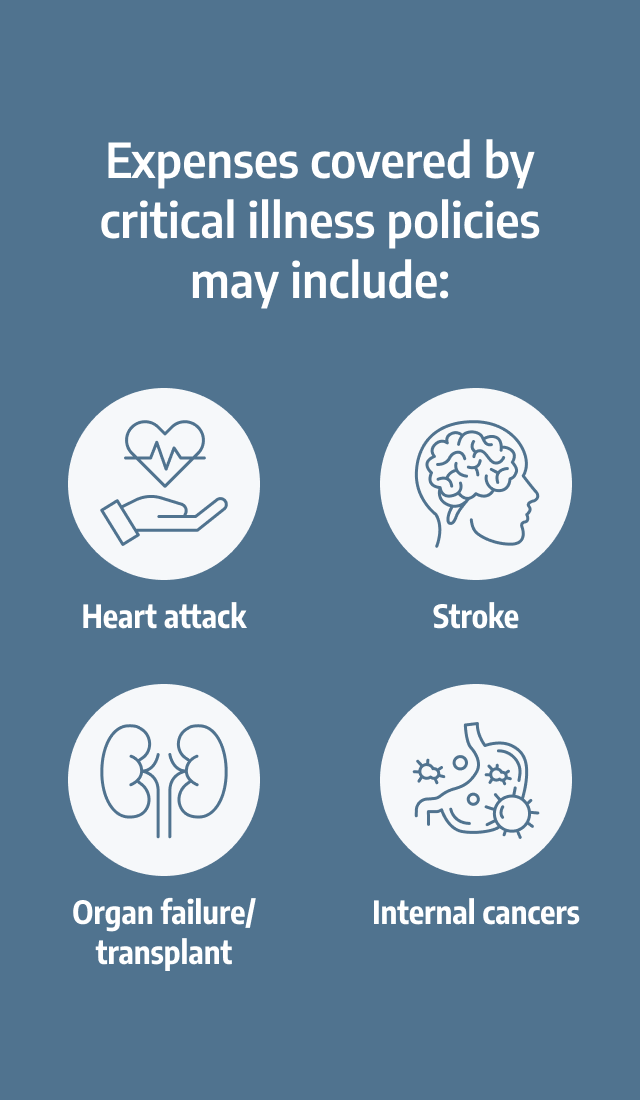Home > Supplemental Insurance > Critical Illness Insurance
See your critical illness insurance coverage options.


Financial protection during your journey to recovery
If you face a major medical crisis – such as a stroke, heart attack, or organ failure – critical illness insurance can protect you from out-of-pocket costs that can add up quickly.
What is critical illness insurance?
Critical illness insurance is a type of supplemental insurance that pays cash benefits to a policyholder if they’re diagnosed with a medical condition that’s covered by the policy.
Critical illness insurance is designed to be used in addition to major medical health coverage, but not replace it. It is not adequate to be your only source of health coverage, as the benefits are capped and the list of covered conditions is limited.


Frequently asked questions about critical illness insurance
How does critical illness insurance work?
Supplemental critical illness insurance policies have lists of specific conditions for which benefits can be paid. The policies have varying benefit amounts, and can pay benefits as a lump sum, a monthly amount, or on a per-treatment basis. You might also see lump-sum critical illness policies that offer optional add-on riders for additional monthly and/or per-treatment benefit amounts.
If you’re diagnosed with a covered medical condition, you’ll receive cash benefits as specified by the policy. The benefits are paid directly to you, and you can use the money however you like: To pay out-of-pocket medical bills (deductible, copays, coinsurance), other living expenses, or both.
Is critical illness insurance worth it?
The answer will depend on your circumstances. If you have robust major medical coverage and disability insurance, and enough money in savings to cover your medical bills and other expenses while dealing with a critical illness, you might not need additional coverage.
But if your major medical insurance has high out-of-pocket costs, a critical illness policy might be a great addition to your overall coverage. Even with a robust health plan, a critical illness supplement might be a good addition if the non-medical costs of a serious medical condition (such as missed work, child care and mortgage payments) would be difficult to manage.
What medical conditions are covered by critical illness policies?
This varies from one policy to another, but all critical illness policies have a specific list of conditions for which they’ll pay benefits. Some policies cover only several basic conditions, while others cover dozens.
Most critical illness policies cover conditions such as heart attack, stroke, organ failure/transplant, and internal cancers (some plans have a partial benefit available for skin cancer). Some policies also provide coverage for severe burns, paralysis, coma, coronary bypass surgery, end-stage renal disease (kidney failure), or significant neurodegenerative conditions such as MS, ALS, or Parkinson’s disease.
Policies differ in terms of whether they provide benefits for recurrence of a condition for which benefits have already been paid.
What’s not covered by a critical illness policy?
Critical illness policies are limited benefit plans and will only pay up to the pre-determined policy limits. And in most cases, these policies will not pay benefits for a medical condition that was pre-existing before you enrolled in the plan.
A critical illness policy will not cover any condition that’s not included on the policy’s list of covered conditions (these lists vary significantly from one policy to another). The policy also won’t cover any conditions or circumstances that it specifically excludes, such as self-inflicted injury, drug or alcohol abuse, illegal activities, acts of war, etc.
How do I choose the best critical illness insurance for my needs?
Weigh premiums vs benefits
Critical illness plans with low premiums tend to have lower benefit amounts and/or a more limited list of covered medical conditions. Plans with higher premiums might pay more when you have a claim, or cover a more extensive list of illnesses. You’ll want to find a good balance between how much the plan costs and what benefits it will provide.
Consider your primary health coverage
A critical illness supplement might be a great choice, but you’ll also want to consider whether you’d be better off putting that money toward a more robust major medical health plan. If you’re confident in your primary coverage and you can afford to also buy a supplemental plan, a critical illness plan can be a great addition to your coverage.
Expected medical care
Most critical illness plans are medically underwritten, which generally means they won’t cover your own pre-existing conditions. But maybe you have a family history of cancer or heart disease or another serious condition. If so, supplemental critical illness insurance might bring you some extra peace of mind.
Who can buy critical illness insurance?
If you’re buying your own individual/family critical illness policy, you’ll need to meet whatever underwriting guidelines the insurance company uses. In general, applications for these policies will ask a handful of medical history questions to determine eligibility, and will not cover people with certain pre-existing medical conditions. They also tend to impose upper age limits, and won’t issue policies to people above a certain age, typically somewhere between 60 and 70 years old.
To enroll in your employer’s group critical illness policy, you have to sign up during open enrollment and be actively working in order to maintain coverage (some plans have portability provisions that allow the policyholder to keep their coverage if they leave the employer). Group policies are generally guaranteed issue, regardless of medical history. But they can still exclude pre-existing conditions and impose waiting periods. And benefits can be reduced once an employee reaches a certain age.
How much does critical illness insurance cost?
The cost of a critical illness policy will depend on whether you buy it yourself or get it from your employer, how old you are, your gender, whether you use tobacco, the insurance company you choose, and the specific benefits of the policy (covered conditions and payout amounts).
In general, the older you are and the more robust the benefits, the higher the monthly cost will be. A person in their 20s might find that they can purchase basic critical illness coverage for just a few dollars a month and quite robust coverage for under $50/month. But a person in their late 50s might find that $50/month only buys them a minimal amount of basic critical illness coverage.
How much critical illness coverage can I buy?
Most insurers that offer critical illness policies will give you the option to pick your benefit amount: It’s common to see these range from $5,000 to $75,000 or more. And you may also have the option to add various riders that will provide additional benefits.
Can I use a critical illness policy in addition to an HSA-qualified health plan?
Yes. In order to contribute to a health savings account (HSA), your only major medical health coverage must be an HSA-qualified high-deductible health plan (HDHP).
But the IRS does allow people with HDHPs to contribute to an HSA even if they also have various types of supplemental coverage, including coverage for “a specific disease or illness.” So a critical illness policy that includes a list of specific covered conditions will not affect a person’s eligibility to contribute to an HSA.
How does critical illness insurance differ from major medical insurance?
Critical illness policies are not regulated by the Affordable Care Act (ACA). So insurers that offer these plans can exclude pre-existing medical conditions or reject an applicant based on medical history. They also impose waiting periods before benefits can be paid for a new medical condition. And critical illness plans have specific caps on the benefits they’ll pay, regardless of how high your medical bills might be.
Major medical health insurance, on the other hand, has to be fully compliant with the ACA if it was issued in 2014 or later. These plans cannot have annual or lifetime benefit maximums, waiting periods, or pre-existing condition exclusions. And if they’re issued in the individual/family or small group market, they must cover the essential health benefits. This includes services for virtually all medical conditions, as opposed to just a list of specific conditions.
Louise Norris is an individual health insurance broker who has been writing about health insurance and health reform since 2006. She has written dozens of opinions and educational pieces about the Affordable Care Act for healthinsurance.org.
Footnotes
- Data and trends. Unos. February 2024. ⤶
- Cancer Facts & Figures 2024. cancer.org. Accessed September, 2024. ⤶
- Heart Attack. Mayo Clinic. October 2023. ⤶

